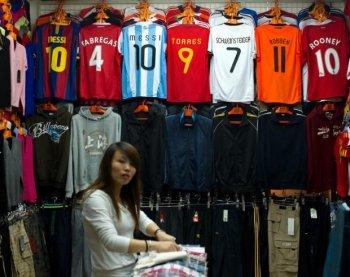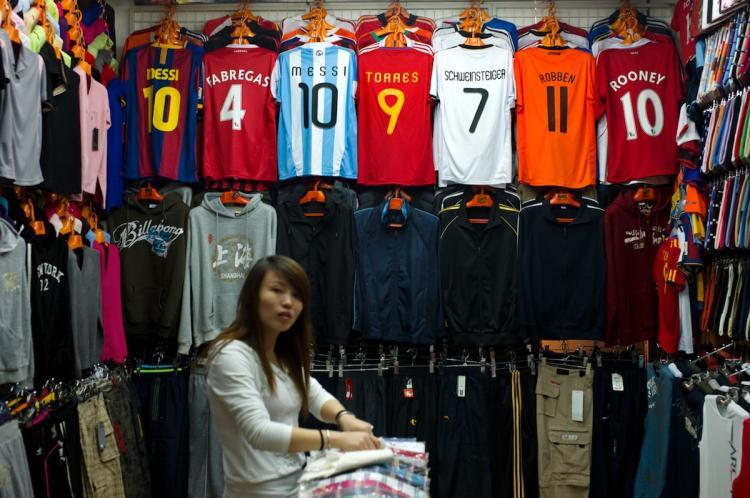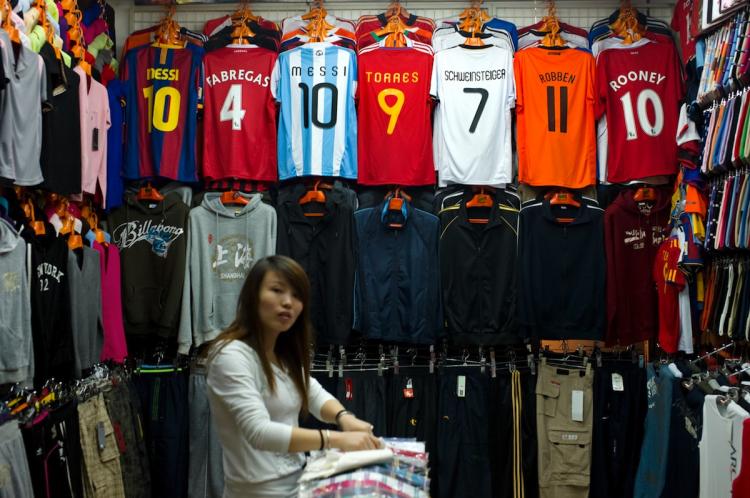Much media coverage has been dedicated to China’s violation of intellectual property rights, but many experts are now questioning the United States’s actions—or lack thereof—in combating patent infringements.
The United States must make China accountable for its violations of World Trade Organization trade rules, according to testimony from industry and government experts before a Congressional-Executive Commission on China held last month.
“The question posed by the Commission is ‘Will China Protect Intellectual Property?’” said Thea Mei Lee, deputy chief of staff at the American Federation of Labor and Congress of Industrial Organizations, before the Commission.
In her own response, she said, “I believe that the answer depends on our government’s actions. To date, despite many efforts, we have not done enough to insist that the Chinese government fully comply with its international obligations.”
Lee said that “until the price for non-compliance exceeds the gains, American workers and businesses will continue to pay a high price, and the Chinese government will continue on its current short-sighted path.”
The majority of speakers reiterated in different words that quiet diplomacy has not worked in the past and will not work going forward. America must go on the offensive and ask its trading partners in other industrialized nations to support its actions and show China that it means business.
American entrepreneurs in the movie, software, and electronic industry, including most U.S. manufacturing companies, have faced an ever increasing deluge of counterfeit products for which they hold intellectual property rights.
Many U.S. experts say that if China wants to become the world’s most dominant trade player, it must give the world more than just lip service, or it will never achieve this desire, especially if it continues to steal propriety information from its trading partners.
“Joshua Cooper Ramo, a strategic consultant and former journalist, concluded in a 2007 report on Brand China, ‘How China is perceived by other nations—and the underlying reality that perceptions reflects—will determine the future of Chinese development and reform.’ And by extension, it will determine the future course of global trade and politics,” according to a 2010 article on the Canadian Business Online website.
“CBP [U.S. Customs and Border Protection Agency] has designated intellectual property rights enforcement as a priority trade issue,” according to a recent statement.
The CBP seized 8,000 batches of products that violated intellectual property rights during the first half of 2010 just before the products could enter the United States. During the same month, the agency donated $2.3 million of counterfeit apparel to the needy. In March, $52 million of counterfeit designer products were seized at Miami’s ports. These are just the tip of the iceberg. CBP publishes a full list of fake, unsafe, and other products that were caught before the products could be delivered to the respective dealers.
In July, 6,000 counterfeit video games that came in on trucks from Mexico were seized. In June, 62 cartons of counterfeit electronic equipment were caught at the Dallas Fort Worth International Airport.
Continued on the next page...
What the CBP calls fakes do not only violate intellectual property rights, or take jobs away from the rightful manufacturers, but also often contain components that harm the consumer.
In particular, “some of the fakes [perfumes] have been found to contain contaminated alcohol, antifreeze, urine, and harmful bacteria. Additionally, these fakes infringe on intellectual property rights, impugning the reputation of companies and taking jobs away from legitimate industries,” according to the CBP.
The CBP asks the U.S. public to report on its online reporting system “e-Allegations” if they suspect products in stores or sold over the Internet to be counterfeit. In reality, vigilant citizens have reported a large number of counterfeit products at stores and on the Internet and have reported them to the CBP.
Many more counterfeit products enter the country than are caught, because the CBP is understaffed and not everything on all trucks, trains, ships, and airplanes can be checked.
China is the main culprit when it comes to counterfeit products. In 2009 alone, more than 70 percent of all counterfeit products that were caught came from China.
“During fiscal year 2009, 21 percent of all shipments to the U.S. came from China. The country also paid 40 percent of all U.S. duties. At the same time, China is a significant trade risk. In fiscal year 2009, more than 70 percent of all intellectual property rights violations stemmed from Chinese imports,” according to the CBP report.
Another issue is that many countries (especially China) want to hide behind a mantle of legitimacy and as a result have established complex transportation procedures. They often ship to second, third, or more countries before shipping the goods to the final destination, making it difficult to discover where products originally come from.
“Counterfeiters have developed sophisticated distribution networks,” states a 2010 Joint Strategic Plan on Intellectual Property Enforcement report, released mid-2010.
“Intellectual property theft in overseas markets is an export killer for American businesses and a job killer for American workers here at home,” said Ambassador Ron Kirk of the United States Trade Representatives office in a statement.
Titleist, a producer of golf equipment, expends more than $2 million annually to counter counterfeiting operations. It cost pharmaceutical company Pfizer Inc. over $3.3 billion between 2007 and 2010 to fight counterfeiters.
“Apparel and footwear together accounted for nearly half of all counterfeit goods seized at the American border,” said Kirk, referring to a statement made by Kevin Burke, president of the American Apparel and Footwear Association.
Counterfeit and pirated software was installed in more than 40 percent of all computers worldwide, costing manufacturers more than $51 billion in lost revenue during 2009, according to a Business Software Alliance (BSA) 2010 study.
In China, 90 percent of all computers run on unlicensed, counterfeit software and the Chinese government uses a vast majority. The estimated loss is $7.6 billion, doubling since 2006. In contrast, licensed and legitimate software sales by American firms in China in 2009 were only $1 billion.
“Products made in China by enterprises that use illegal software hurt American competitiveness and in many cases displace US jobs,” testified Robert W. Holleyman II, president and CEO of Business Software Alliance, before the Congressional Executive Commission on China in September.
The United States must make China accountable for its violations of World Trade Organization trade rules, according to testimony from industry and government experts before a Congressional-Executive Commission on China held last month.
“The question posed by the Commission is ‘Will China Protect Intellectual Property?’” said Thea Mei Lee, deputy chief of staff at the American Federation of Labor and Congress of Industrial Organizations, before the Commission.
In her own response, she said, “I believe that the answer depends on our government’s actions. To date, despite many efforts, we have not done enough to insist that the Chinese government fully comply with its international obligations.”
Lee said that “until the price for non-compliance exceeds the gains, American workers and businesses will continue to pay a high price, and the Chinese government will continue on its current short-sighted path.”
The majority of speakers reiterated in different words that quiet diplomacy has not worked in the past and will not work going forward. America must go on the offensive and ask its trading partners in other industrialized nations to support its actions and show China that it means business.
American entrepreneurs in the movie, software, and electronic industry, including most U.S. manufacturing companies, have faced an ever increasing deluge of counterfeit products for which they hold intellectual property rights.
Many U.S. experts say that if China wants to become the world’s most dominant trade player, it must give the world more than just lip service, or it will never achieve this desire, especially if it continues to steal propriety information from its trading partners.
“Joshua Cooper Ramo, a strategic consultant and former journalist, concluded in a 2007 report on Brand China, ‘How China is perceived by other nations—and the underlying reality that perceptions reflects—will determine the future of Chinese development and reform.’ And by extension, it will determine the future course of global trade and politics,” according to a 2010 article on the Canadian Business Online website.
Catching Fake and Harmful Products at the US Border
“CBP [U.S. Customs and Border Protection Agency] has designated intellectual property rights enforcement as a priority trade issue,” according to a recent statement.
The CBP seized 8,000 batches of products that violated intellectual property rights during the first half of 2010 just before the products could enter the United States. During the same month, the agency donated $2.3 million of counterfeit apparel to the needy. In March, $52 million of counterfeit designer products were seized at Miami’s ports. These are just the tip of the iceberg. CBP publishes a full list of fake, unsafe, and other products that were caught before the products could be delivered to the respective dealers.
In July, 6,000 counterfeit video games that came in on trucks from Mexico were seized. In June, 62 cartons of counterfeit electronic equipment were caught at the Dallas Fort Worth International Airport.
Continued on the next page...
What the CBP calls fakes do not only violate intellectual property rights, or take jobs away from the rightful manufacturers, but also often contain components that harm the consumer.
In particular, “some of the fakes [perfumes] have been found to contain contaminated alcohol, antifreeze, urine, and harmful bacteria. Additionally, these fakes infringe on intellectual property rights, impugning the reputation of companies and taking jobs away from legitimate industries,” according to the CBP.
The CBP asks the U.S. public to report on its online reporting system “e-Allegations” if they suspect products in stores or sold over the Internet to be counterfeit. In reality, vigilant citizens have reported a large number of counterfeit products at stores and on the Internet and have reported them to the CBP.
Many more counterfeit products enter the country than are caught, because the CBP is understaffed and not everything on all trucks, trains, ships, and airplanes can be checked.
China is the main culprit when it comes to counterfeit products. In 2009 alone, more than 70 percent of all counterfeit products that were caught came from China.
“During fiscal year 2009, 21 percent of all shipments to the U.S. came from China. The country also paid 40 percent of all U.S. duties. At the same time, China is a significant trade risk. In fiscal year 2009, more than 70 percent of all intellectual property rights violations stemmed from Chinese imports,” according to the CBP report.
Another issue is that many countries (especially China) want to hide behind a mantle of legitimacy and as a result have established complex transportation procedures. They often ship to second, third, or more countries before shipping the goods to the final destination, making it difficult to discover where products originally come from.
“Counterfeiters have developed sophisticated distribution networks,” states a 2010 Joint Strategic Plan on Intellectual Property Enforcement report, released mid-2010.
Cost of Counterfeit Products
“Intellectual property theft in overseas markets is an export killer for American businesses and a job killer for American workers here at home,” said Ambassador Ron Kirk of the United States Trade Representatives office in a statement.
Titleist, a producer of golf equipment, expends more than $2 million annually to counter counterfeiting operations. It cost pharmaceutical company Pfizer Inc. over $3.3 billion between 2007 and 2010 to fight counterfeiters.
“Apparel and footwear together accounted for nearly half of all counterfeit goods seized at the American border,” said Kirk, referring to a statement made by Kevin Burke, president of the American Apparel and Footwear Association.
Counterfeit and pirated software was installed in more than 40 percent of all computers worldwide, costing manufacturers more than $51 billion in lost revenue during 2009, according to a Business Software Alliance (BSA) 2010 study.
In China, 90 percent of all computers run on unlicensed, counterfeit software and the Chinese government uses a vast majority. The estimated loss is $7.6 billion, doubling since 2006. In contrast, licensed and legitimate software sales by American firms in China in 2009 were only $1 billion.
“Products made in China by enterprises that use illegal software hurt American competitiveness and in many cases displace US jobs,” testified Robert W. Holleyman II, president and CEO of Business Software Alliance, before the Congressional Executive Commission on China in September.






